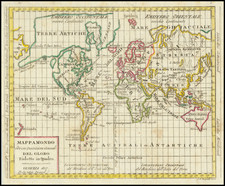Rare miniature example of the Latin edition of Harmann Schedel's map of the World, published by Hans Schönsperger in Augsburg. This miniature edition is much rarer than the original edition.
Schedel's map is one of the earliest obtainable world maps, and, visually, one of the most evocative of its period. Published just 40 years after the invention of printing, the Schedel map presents the world as seen just prior to Columbus' voyage and the rounding of the Cape of Good Hope by Dias. The engraving also reveals the medieval attitude toward peoples of distant lands through the grotesque creatures found on both sides; these creatures were believed to inhabit unexplored areas. This helps to explain the ease with which Europeans were able to demonize indigenous peoples they encountered in the New World. The general contours of the map primarily show the influence of the most important geographical work of antiquity, Ptolemy's Geographia, which had been forgotten during the Middle Ages. Many medieval notions are nevertheless incorporated: the Indian Ocean is shown in its land-locked, pre-discovery state, for example. The inclusion of illustrations of Japhet, Shem, and Ham (the sons of Noah who re-populated the earth after the Flood) in the corners suggests the theology-centered medieval view of the world. Also on the map is the familiar decorative motif of the twelve wind-heads that is found on many early printed world maps.
Hartmann Schedel's Liber Chronicarum: Das Buch der Croniken und Geschichten (loosely transalated as World Chronicle, but popularly referred to as the Nuremberg Chronicle, based upon the city of its publication), was the first secular book to include the style of lavish illustrations previously reserved for Bibles and other liturgical works. The work was intended as a history of the World, from Creation to 1493, with a final section devoted to the anticipated Last Days of the World. It is without question the most important illustrated secular work of the 15th Century and its importance rivals the early printed editions of Ptolemy's Geographia and Bernard von Breydenbach's Perengrinatio in Terram Sanctam in terms of its importance in the development and dissemination of illustrated books in the 15th Century. Published in Nuremberg by Anton Koberger, the book was printed in Latin and 5 months later in German (translated by George Alt), and enjoyed immense commercial success.
A reduced size version of the book was published in 1496 in Augsburg by Johann Schonsperger, with a Latin edition published in February 1497. These smaller pirated editions are much rarer than the original folio sized edition.
Schedel's World map is based upon Ptolemy, omitting Scandinavia, southern Africa and the Far East, and depicting the Indian Ocean as landlocked. The depiction of the World is surrounded by the figures of Shem, Japhet and Ham, the sons of Noah.









![[ Genesis / Creation ] De Schepping der Wereldt Volgens de Beschryving van Mozes. 1 Plaat [in set with] De Schepping der Wereldt Volgens de Beschryving van Mozes. 2. Plaat](https://storage.googleapis.com/raremaps/img/small/101543.jpg)


![[ Indian Cave and Rock Paintings ] World Primitive Rock Art -- The Conquest of Indian America](https://storage.googleapis.com/raremaps/img/small/93916.jpg)
![[ Ancient World ] Aevi Veteris, Typus Geographicus](https://storage.googleapis.com/raremaps/img/small/85526.jpg)
![Сны Султана (Картина 2) [Dreams of the Sultan. Scene 2]](https://storage.googleapis.com/raremaps/img/small/60238.jpg)